| Reviews & Columns |
|
Reviews DVD TV on DVD Blu-ray 4K UHD International DVDs In Theaters Reviews by Studio Video Games Features Collector Series DVDs Easter Egg Database Interviews DVD Talk Radio Feature Articles Columns Anime Talk DVD Savant Horror DVDs The M.O.D. Squad Art House HD Talk Silent DVD
|
DVD Talk Forum |
|
|
| Resources |
|
DVD Price Search Customer Service #'s RCE Info Links |
|
Columns
|
|
|
Torpedo Run (Warner Archive Collection)
Standard pigboat opus fails to capitalize on its gripping premise. Warner Bros.' Archive Collection of hard-to-find library and cult titles has released Torpedo Run, the 1958 WWII submarine actioner from Metro-Goldwyn-Mayer starring Glenn Ford, Ernest Borgnine, Diane Brewster, Dean Jones, L.Q. Jones, Philip Ober, Richard Carlyle, and for some reason, England's Robert Hardy. Curiously flat for what should have been a big CinemaScope blow-out, Torpedo Run's underwater combat scenes are barely acceptable (the model work comes and goes), while its intriguing set-up--Commander Ford deliberately blows up his own family to do his duty--is given rote lip-service, and no more. An original trailer is included in this fair anamorphically-enhanced widescreen color transfer.
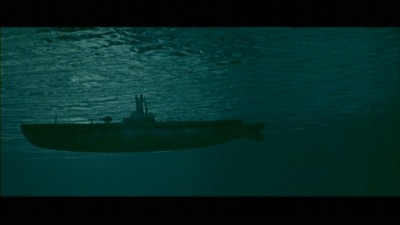
The South Pacific, 1942. U.S.N. Lieutenant Commander Barney Doyle (Glenn Ford, intense and boring), the best sub skipper in the fleet according to his C.O., Admiral Samuel Setton (Philip Ober), is in hot pursuit of Japan's most feared "flattop," the aircraft carrier Shinaru, which led the cowardly sneak attack on Pearl Harbor. Tensions are running high in the cramped Greyfish, with the crew taking their lead from their worried skipper, whose wife, Jane (Diane Brewster, completely wasted, yet again), and little girl Dee Dee (Kim Beck), haven't been heard from in the ten months since Japan invaded Manila (Jane, a Navy brat, was born there and refused to leave when asked repeatedly by her husband). Best friend and Exec Officer Lieutenant Archer "Arch" Sloan (Ernest Borgnine, thwarted...but the only good thing here) is on board, trying his best to calm the flinty skipper, but it's a losing battle. When Setton receives word through the Japanese that all the U.S. civilians and personnel from the Philippines have been "safely" interned, he's suspicious as to why the enemy would give them this info--a suspicion that's borne out when ComSubPac discovers the Shinaru will be steaming back to Tokyo Bay...with the U.S. civilians used as human shields on a transport screening the flattop ("Those...clever devils," grimaces Setton). This double-edged sword of intelligence is transmitted to Doyle, and it's up to him how to proceed next. He knows his duty, despite all the begging from Sloan to either give the Shinaru a miss or to let him actually be the one to fire the torpedoes. Doyle does his duty, and tragically, the transport is hit, with the remaining survivors left in the waters to drown as the untouched Shinaru waits patiently to blow the Greyfish out of the water. Doyle has no choice but to retreat, vowing holy vengeance on the Shinaru.
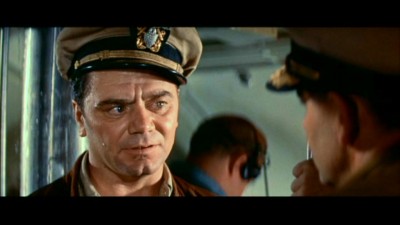
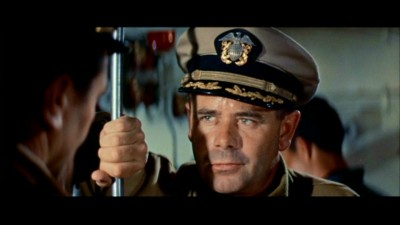
According to a couple of sources I accessed, Torpedo Run didn't return a profit to then-struggling M-G-M when it was released in October, 1958. Glenn Ford, after appearing in one financially successful movie after another throughout the early to mid-50s, had rather miraculously found himself at the very top of the annual Quigley exhibitors' poll for the Top Ten most popular stars of 1958... "miraculously" because he never headlined a truly blockbuster hit (the closest he probably came was M-G-M's The Blackboard Jungle, back in 1955). However, right at the height of this public acknowledgment of his success, he drastically cut back his on-screen appearances (two movies for 1959, and only one for 1960), as high-cost failures like 1960's Cimarron, 1961's Pocketful of Miracles, and the absolutely disastrous remake, The Four Horsemen of the Apocalypse in 1962, set him on a precipitous decline in terms of A-list opportunities. It's anybody's guess as to why Torpedo Run didn't score higher b.o.. Perhaps it was overexposure for Ford (he had no less than four movies released in '58), or subject matter traditionally unappealing to women, a core element of his fan base (when Ford, right or wrong, willingly kills his wife and kid here out of a sense of duty, I would imagine his female fans in the audience were not amused...). Or maybe it was something as simple as too-familiar work within an admittedly narrow genre (not a lot of room to stretch, so to speak, within the submarine action pic), with sometimes iffy special effects further detracting. It's hard to say (I always enjoyed Torpedo Run when it played on our afternoon movie show when I was a kid, and for the same reasons I loved all those Godzilla outings: that slip-shod model work looked exactly like the toys I had. Crappy effects weren't a limitation; just the opposite--they made a stronger connection to the movie).
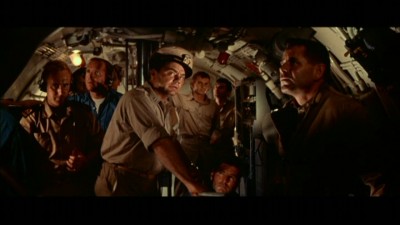
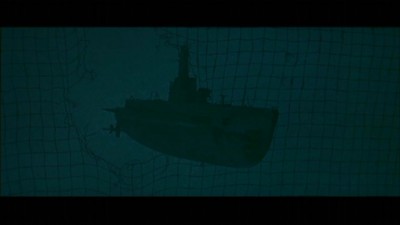
No, what bothers me now about Torpedo Run isn't unconvincing model work but rather an oddly tentative production that wastes a first-rate set-up. Written by Richard Sale (Mr. Belvedere Goes to College, Suddenly, Abandon Ship) and William Wister Haines (Command Decision, which also features a somewhat similar moral dilemma about command sending men to certain death, The Racket, The Wings of Eagles), Torpedo Run attempts to prep us to care more about Ford's dilemma by awkwardly inserting a few flashbacks with Diane Brewster (to get a woman on the poster, no doubt, for the female ticket buyers), a technique that's as ineffectual (they're far too brief to have any impact) as it is poorly integrated (they're inserted, almost diabolically, at points were a flashback is the last thing we want). They're simply not necessary. Ford's decision is monumental enough that just us knowing that his unseen wife and child are on board that ship, is satisfactory for producing the required dread and suspense (indeed, if the producers really wanted impact, Brewster and the child should have only been seen for a few seconds, struggling in the water, when Ford sneaks a peek through the 'scope at the sinking transport). Even more troubling is what the script does with Ford after he makes his fatal decision. At first I admired the script's terseness in "explaining" Ford's action: it doesn't spell out his motives ("That's what we're here for, " is all the explaining he does for attempting to sink the flattop). We have to get where his head is at: his duty as the officer of a U.S. sub is to sink that flattop, regardless of the risk to other personnel--even his own family. And the suggestion that Borgnine do the actual shooting is repugnant to him: it's his responsibility--the burden of command--and his alone.
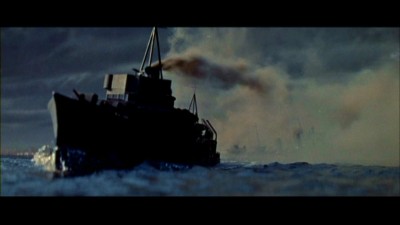
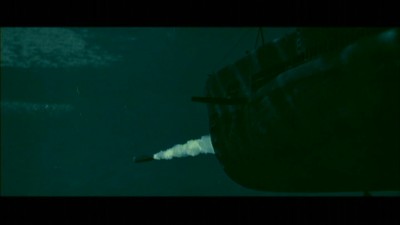
Great. Fine. An Abraham-esque tragedy ripe for psychological exploration-through-action. So...where in Torpedo Run do we go with that? Try "nowhere," because just when we want to see the effects of this decision on Ford's mental and emotional health (and while we're at it, how about just a little discussion about the burdens of command?), the movie blows the klaxon, battens down the hatches, and dives. Total shutdown. Ford sends a fish right into wife and baby's cabin, steams off, executes a daring raid inside Tokyo Bay without hesitation, escapes...and then sleeps for three days, with the occasional toss or turn or grimace (much is made of this sleep between Ford and Borgnine, as if it's potentially the worst thing he could have done...instead of killing 1400 civilians). That's it. Back at Pearl, he's raring for revenge, and when he finally gets it, he's quietly relieved. You could try and make a tenuous case that Torpedo Run's Hemingway-esque refusal to be explicit about action-man Ford's psychological torment is admirable; however, considering there's no accompanying effort to illuminate him through that action (director Joseph Pevney couldn't even spell "mise-en-scene," let alone employ it), we're stuck with a hero who seems not devastated but rather mildly peeved at his monstrously fatal decision. It's too good a story twist to leave as just a minor Moby Dick motivator for Ford's vengeful quest after the Japanese flattop. Other subplots and character motivations are hinted and feinted at, like novice officer Dean Jones learning the ropes (that line is dropped fast), or Borgnine's break with Ford after Ford discovers Borgnine told Command about his three day sleep (and short of an outright love affair, how could the scripters possibly think we'd buy a career officer like Borgnine passing up his own wartime promotion to command, in order to subordinate himself to Ford?), but none are as damaging as this glaring central hole in the movie's whole raison d'etre.
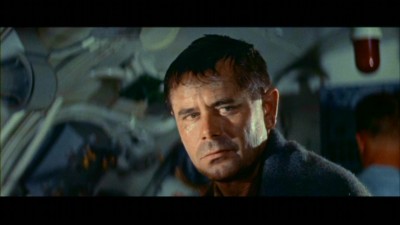
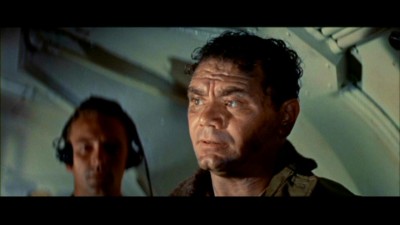
And that just leaves the toys in the bath tub. And what toys they are. If those big, blank gray interior bulkheads were what the subs really looked like inside back then, they I say throw in a bunch of historically inaccurate gauges and levers and valves, because this is one mighty boring-looking sub movie. If you have CinemaScope at your disposal, why the hell wouldn't you fill up that huge frame? Jack up the claustrophobia by making it visually tight in there. Director Pevney, who swung wide with titles like Man of a Thousand Faces and Female on the Beach, to Congo Crossing and Cash McCall, doesn't know what the hell he's doing with CinemaScope, anyway, cramming everyone smack dab in the middle of the frame, with lots of dead, uninformed space on either side. As for the model work, the underwater stuff isn't too bad, actually. There's a great comic book panel-worthy shot that must have looked sweet on an immense CinemaScope screen: the bow of the sub fills one half of the frame as it shoots a fish home through the greenish void. But when they go in for close-ups, the sub looks like a Monogram model in a washtub. And the boats above the water are even worse (the smoke never looks right, like a cee-gar was stuck inside). But it's not just the props craftsmanship that at times is at fault here, it's also a dreary repetition of dives and depth charges and explosions that are no more exciting the first time you seen them than the fiftieth (I guess the men escaping the sub via Momsen lung rebreathers in arctic water is kinda cool at first...before it drags on, too). Without a credible storyline, or engaging character motivation, or even exciting action for action's sake, it's no wonder audiences deep-sixed Torpedo Run.
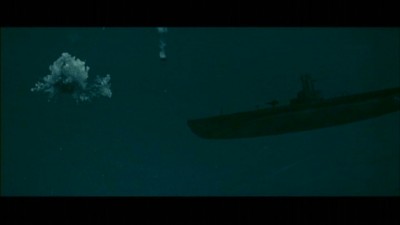
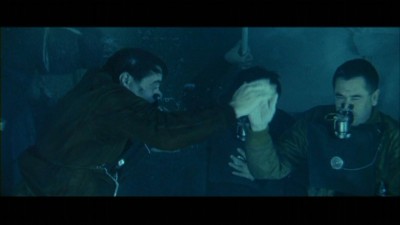
The Video:
The anamorphically-enhanced, 2.40:1 (as stated on the case, although it looked closer to 2.35 to me) widescreen transfer for Torpedo Run is unimpressive: washed out, sickly yellowish/brownish color, a soft image, grain, and scratches and dirt.
The Audio:
The Dolby Digital English mono audio track is okay, with low hiss and a decent-enough re-recording level. No subtitles or closed-captions.
The Extras:
An original trailer is included ("That fabulous crew! " No wonder nobody went...).
Final Thoughts:
Crash dive. A potentially fascinating premise is botched with a sketchy, half-hearted script and a peculiarly cautious production. Torpedo Run is a rental for die-hard WWII action fans and submarine freaks only.
Paul Mavis is an internationally published movie and television historian, a member of the Online Film Critics Society, and the author of The Espionage Filmography.


|
| Popular Reviews |
| Sponsored Links |
|
|
| Sponsored Links |
|
|
| Release List | Reviews | Shop | Newsletter | Forum | DVD Giveaways | Blu-Ray | Advertise |
|
Copyright 2024 DVDTalk.com All Rights Reserved. Legal Info, Privacy Policy, Terms of Use,
Manage Preferences,
Your Privacy Choices | |||||||












